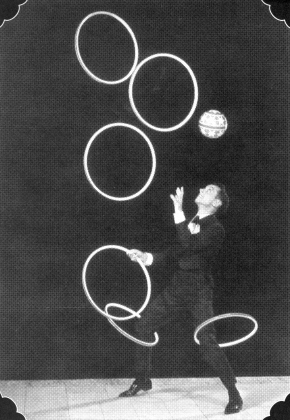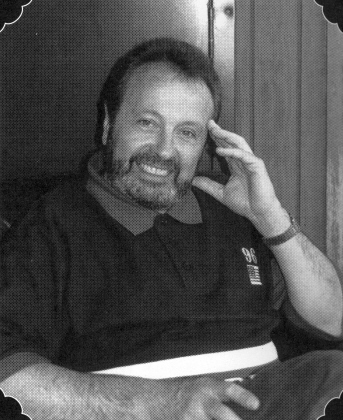
Bramson performing in 1965 (from the Ziethen "Postkartenbuch" collection) |

Bob Bramson today (Scott Malone photo) |
Page 36 Summer 1996
|
But
even with that moderate practice regimen, he was juggling five hoops
at age eight. He learned many valuable lessons about juggling during
those early years. He remembers practicing in a circus building in
His
first performance came in May 1943, at the age of nine. The Bramsons
were attending a children's performance in Goteburg, Sweden. At the
end of the show, the emcee asked if anyone in the audience could
perform. "And I screamed, 'Yes, I can! I can!' And this was the
beginning of my juggling career," Bramson recalled. He
juggled five hoops, and didn't miss anything. "My parents were
very proud," he remembered.
Shortly
after that, he joined his parents' act, and first experienced the
stress of performance. "You go on stage and it is the toughest
thing in the world," he said. "I was
As
a young juggler, he developed practice habits that even outdid his
parents. After coming home from school, he would rehearse for eight or
nine hours, sometimes wearing the skin off his palms. He said, "I
was a maniac. Sometimes at 11 or midnight, my mother would come to me
and say, 'Now stop, Bobby. That is enough now.' I was crazy for
this."
Once
he had mastered his parents' act, he developed a new practice
philosophy. "I always rehearsed new tricks - but I never put them
in my act. I always tried something new. I tried nine hoop juggling,
but I never performed it because it was never 100 percent."
He
does not mind that he was unable to perform nine hoops, even after 10
years of practice, for two reasons: It has made his seven-hoop
juggling seem like nothing, but also because jugglers "are not in
the Olympic games."
He
explained, "This is what I don't like, when we say, 'Now we are
juggling nine, now we are juggling 10, now we are juggling 11. Forget
it! This is not the main thing of show business. I know artists who do
acts juggling three balls that are fantastic. It's how they juggle and
how they present three balls. That's the difference between art and
the Olympic games. There you have to be the fastest, or the strongest,
or whatever. But not in art. Artists entertain people. And make them
happy!"
Bob
performed with his parents across
His
father's death did not stop the act. Bob and Gerti went on the next
night, and eventually found that performing as a duo was not so
difficult. His mother had always been the choreographer, and with her
careful planning, there was never a dead moment. "When you still
have a partner, she always can help you. We did double tricks. The
whole act was like a picture, going one thing into another, with never
a moment of emptiness," he said.
Bramson
found that the most important thing about having a partner was having
someone there to help out when he dropped a prop. But in 1964 his
mother retired and he found himself alone on stage. "It started
getting really hard to work all by myself, to have a driving
act," he admitted.
He
developed his signature drop line out of the blue one night on stage
during a difficult moment. He explained, "For my very last trick
the hoop was supposed to go around and into the little screen. But the
stage was very difficult, and I missed it once. Then I missed it three
times, and I didn't know what to do."
On
his fourth attempt, sweating with anxiety, he released the hoop and
watched it slowly
roll off, in the wrong direction. "Out of desperation, I
said, 'Johnny, come back!'" And the hoop did! |

Bramson performing in 1965 (from the Ziethen "Postkartenbuch" collection) |

Bob Bramson today (Scott Malone photo) |